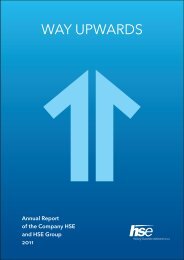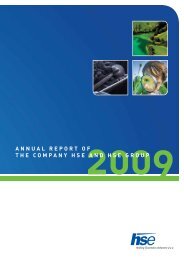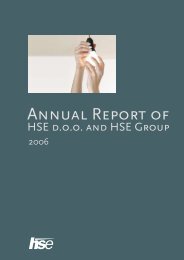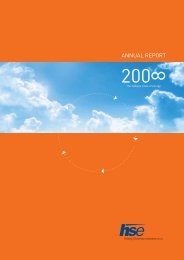Annual report - HSE
Annual report - HSE
Annual report - HSE
You also want an ePaper? Increase the reach of your titles
YUMPU automatically turns print PDFs into web optimized ePapers that Google loves.
Write-downs in value include amortisation/depreciation costs related to consistent<br />
transfer of value of amortisable intangible assets and depreciable property, plant and<br />
equipment and investment property.<br />
Write-downs in value also include impairments, write-downs and losses from the sales of<br />
intangible assets and property, plant and equipment as well as impairments or write down<br />
of receivables and inventories.<br />
Labour costs are historical costs that refer to salaries and similar values in gross amounts<br />
as well as duties that are calculated from this basis and are not an integral part of gross<br />
amounts. These costs can be directly charged against creation of products and services<br />
(costs of direct work) or they have the nature of indirect costs and are comprised in relevant<br />
purpose (functional) groups of indirect costs.<br />
Other operating expenses occur in relation to creation of provisions, environmental<br />
charges and other duties.<br />
Financial expenses comprise borrowing costs, including related derivatives and<br />
impairment of investments. Interest expenses are recognised upon their occurrence, in the<br />
amount of agreed-upon interest rate.<br />
5.5.7.16 Tax<br />
Taxes include current and deferred tax liabilities. Current tax is included in the consolidated<br />
income statement. Deferred tax in recognised in the consolidated income statement and in<br />
the consolidated statement of financial position.<br />
Current tax liabilities are based on taxable profit for the period. The taxable profit defers<br />
from net profit <strong>report</strong>ed in the profit or loss, since it excludes the items of revenue or<br />
expenses that are taxable or deductible in other years as well as items that are never<br />
taxable or deductible. The Group companies’ current tax liabilities are calculated with tax<br />
rates that are applicable on the <strong>report</strong>ing date. If current tax liability is lower than advances<br />
paid, current tax receivable is posted.<br />
Country Effective tax rate in 2012<br />
Slovenia 18%<br />
Croatia 20%<br />
Serbia 10%<br />
Macedonia 10%<br />
Bosnia and Herzegovina 10%<br />
Bulgaria 10%<br />
Italy 27.5%<br />
Deferred tax is completely disclosed using the liabilities method after the statement of<br />
financial position for temporary differences arising between the tax value of assets and<br />
liabilities and their carrying amounts in financial statements. Deferred income tax is defined<br />
using tax rates (and legislation) applicable on the date of consolidated financial position<br />
and for which it is expected to be in use when the receivable for deferred tax is realised or<br />
the liability for deferred tax is settled.<br />
5 Financial Report of <strong>HSE</strong> Group<br />
<strong>Annual</strong> Report <strong>HSE</strong> 2012<br />
182<br />
A deferred tax asset is recognised, if there is a possibility that a taxable profit will be<br />
available in the future, from which it will be possible to utilise temporary differences. It<br />
represents the amount of the calculated corporate income tax on deductible temporary<br />
differences.<br />
Deferred tax liabilities represent the assessed amount of corporate income tax and taxable<br />
temporary differences, which results in a higher tax payable in the future.
















